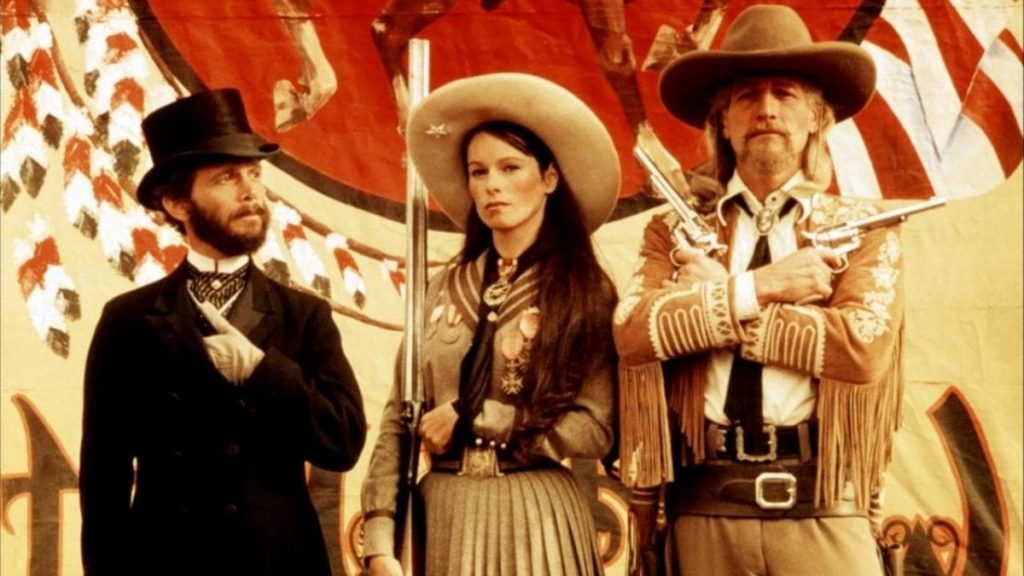
The cinema of Robert Altman is unique in the history of American filmmaking. More than any other director, Robert Altman has been able to apply his style to every genre of film he has worked in since the late sixties. His background in documentary filmmaking and television heavily informs his narrative work, particularly his ability to create meaningful ensemble pieces and to break down a narrative into long, closely analyzed events. His masterpieces, Nashville, McCabe & Mrs. Miller and Short Cuts are among some of the most influential American films ever made.
But what I am interested in is how, in Buffalo Bill & The Indians Or Sitting Bull’s History Lesson (1976), Altman addresses the importance and the treatment of history in American movies. Robert Altman’s best work has consistently analyzed contemporary America with the hope of learning or revealing something about America and its inhabitants. Sometimes Altman has answers/revelations to the questions his narratives pose, other times all he can succeed in doing is making a pointed observation which leads to a pointed question for the audience.
The film focuses on William F. Cody (Paul Newman) and his Wild West Show, and how they grapple with the moral questions of re-writing history to suit their entertainment needs. Time and again, the ignorant and self-serving Cody is pitted against the truth of what actually happened in this country’s history. Sitting Bull (Frank Kaquitts) and Ned Buntline (Burt Lancaster) consistently present this truth to Cody, for whom it is an embarrassing annoyance better ignored, and even better yet, adapted to make himself the hero. It is this conflict that makes this film so compelling.
Consider the paradox. Altman is constructing a fictitious narrative based on historical events and real people. But the events and people that supply Altman with his source material are in turn perpetuating the very same artifice. This paradox is exactly what Altman is asking his audience to question and consider. On America’s bicentennial, Altman asks his audience whether or not it is justifiable that the iconography of American history is based on fabrications and lies. Choosing Buffalo Bill as a subject and Paul Newman to play him was perhaps the wisest choice for this investigation.
Altman isn’t so much concerned with the mundane goings on of the show or the conflicts that arise from these events that just serve as secondary background development. The concern is for the ethical question at hand and how Buffalo Bill will resolve these questions, and how many concessions he will make for the sake of his own ego and benefactors. In one scene, Buffalo Bill rejects Sitting Bull’s first hand account of his battle with Custer. Bill fires Sitting Bull as a result of this debate. However, Annie Oakley (Geraldine Chaplin) threatens to quit if Sitting Bull leaves. Now Bill has to choose between admitting he’s taken “creative liberties” with Sitting Bull’s story and losing one of his acts. He chooses Oakley.
If William F. Cody represents popular history and Sitting Bull the factual history, then the conflict and the havoc it wrecks on Cody’s conscious becomes much more clear. It is this application of thematic issues onto characters which constitutes the film’s primary conflict. Both men/histories inform one another, bleeding into each other, until Cody refuses to compromise anymore.
During the last act of The Wild West Show in the film, it is revealed that Cody has replaced Sitting Bull with an actor stand-in. The factual history has lost out to the plastic, popular and patriotic history. A victory for the film’s title character is the loss of a nation. In this respect, Buffalo Bill & The Indians Or Sitting Bull’s History Lesson is one of Altman’s most pessimistic films. Altman single handedly knocks the wind out of our American heritage, exposing the ignorance and corruption from which it was born.
